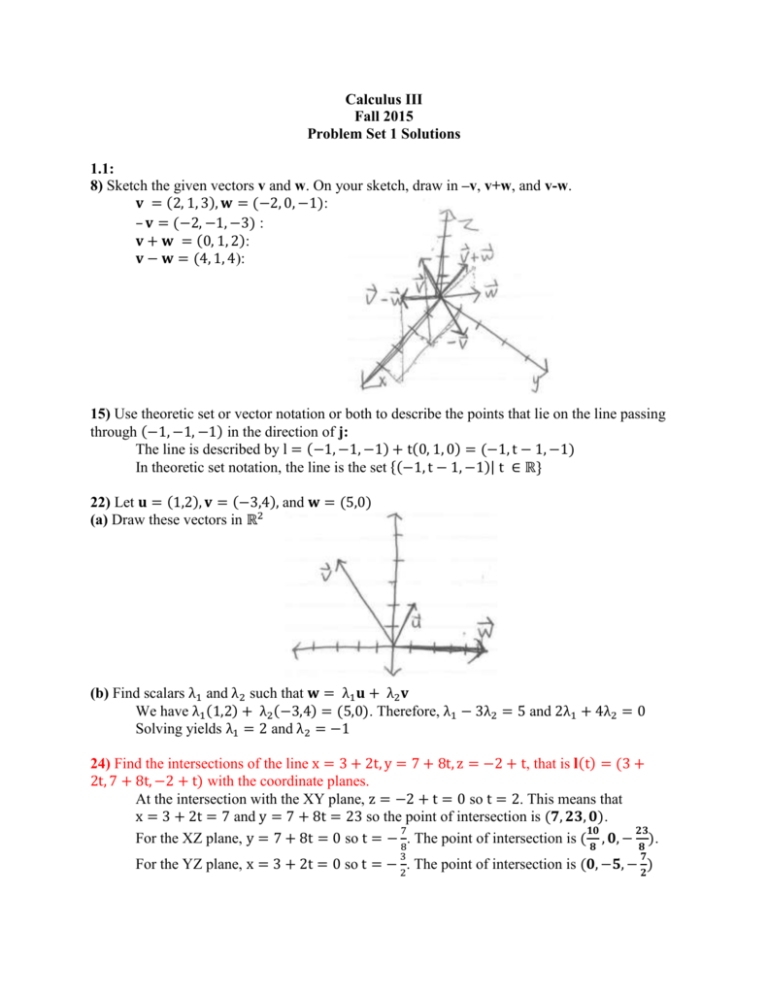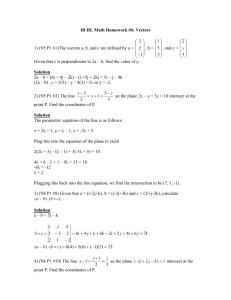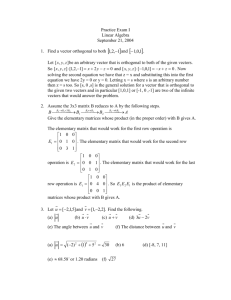Solutions 1
advertisement

Calculus III
Fall 2015
Problem Set 1 Solutions
1.1:
8) Sketch the given vectors v and w. On your sketch, draw in –v, v+w, and v-w.
𝐯 = (2, 1, 3), 𝐰 = (−2, 0, −1):
– 𝐯 = (−2, −1, −3) :
𝐯 + 𝐰 = (0, 1, 2):
𝐯 − 𝐰 = (4, 1, 4):
15) Use theoretic set or vector notation or both to describe the points that lie on the line passing
through (−1, −1, −1) in the direction of j:
The line is described by l = (−1, −1, −1) + t(0, 1, 0) = (−1, t − 1, −1)
In theoretic set notation, the line is the set {(−1, t − 1, −1)| t ∈ ℝ}
22) Let 𝐮 = (1,2), 𝐯 = (−3,4), and 𝐰 = (5,0)
(a) Draw these vectors in ℝ2
(b) Find scalars λ1 and λ2 such that 𝐰 = λ1 𝐮 + λ2 𝐯
We have λ1 (1,2) + λ2 (−3,4) = (5,0). Therefore, λ1 − 3λ2 = 5 and 2λ1 + 4λ2 = 0
Solving yields λ1 = 2 and λ2 = −1
24) Find the intersections of the line x = 3 + 2t, y = 7 + 8t, z = −2 + t, that is 𝐥(t) = (3 +
2t, 7 + 8t, −2 + t) with the coordinate planes.
At the intersection with the XY plane, z = −2 + t = 0 so t = 2. This means that
x = 3 + 2t = 7 and y = 7 + 8t = 23 so the point of intersection is (𝟕, 𝟐𝟑, 𝟎).
7
𝟏𝟎
𝟐𝟑
For the XZ plane, y = 7 + 8t = 0 so t = − 8. The point of intersection is ( 𝟖 , 𝟎, − 𝟖 ).
3
𝟕
For the YZ plane, x = 3 + 2t = 0 so t = − 2. The point of intersection is (𝟎, −𝟓, − 𝟐)
1.2:
Compute ‖𝐮‖, ‖𝐯‖ and 𝐮 ⋅ 𝐯 for the given vectors in ℝ3
8) 𝐮 = 5𝐢 − 𝐣 + 2𝐤 = (5, −1,2), 𝐯 = 𝐢 + 𝐣 − 𝐤 = (1,1, −1)
‖𝐮‖ = √𝐮 ⋅ 𝐮 = √52 + (−1)2 + 22 = √30
‖𝐯‖ = √𝐯 ⋅ 𝐯 = √12 + 12 + (−1)2 = √3
𝐮 ⋅ 𝐯 = 5 ∗ 1 − 1 ∗ 1 + 2 ∗ −1 = 2
10) 𝐮 = −𝐢 + 3𝐤 = (−1, 0, 3), 𝐯 = 𝟒𝐣 = (0, 4, 0)
‖𝐮‖ = √𝐮 ⋅ 𝐮 = √(−1)2 + 32 = √10
‖𝐯‖ = √𝐯 ⋅ 𝐯 = √42 = 4
𝐮 ⋅ 𝐯 = −1 ∗ 0 + 0 ∗ 4 + 3 ∗ 0 = 0
18) Find all values of x such that (x, 1, x) and (x, −6,1) are orthogonal.
For two vectors to be orthogonal, the dot product must equal zero. In this case,
0 = (x, 1, x) ⋅ (x, −6,1) = x ∗ x + 1 ∗ −6 + x ∗ 1 = x 2 + x − 6
0 = (x + 3)(x − 2) so 𝐱 = −𝟑 and 𝐱 = 𝟐
20) Find the projection of 𝐮 = −𝐢 + 𝐣 + 𝐤 onto 𝐯 = 2𝐢 + 𝐣 − 3𝐤
𝐯⋅𝐮
The equation for the projection of u onto v is 𝐩 = ‖𝐯‖𝟐 𝐯. Plugging in we get
𝐩=
(2,1,−3)⋅(−1,1,1)
22 +12 +(−3)2
(2, 1, −3) =
−4
14
4
2 6
4
2
6
(2, 1, −3) = (− , − , ) = − 𝐢 − 𝐣 + 𝐤
7
7 7
7
7
7
26) Find the line through (3, 1, −2) that intersects and is perpendicular to the line
x = −1 + t, y = −2 + t, z = −1 + t.
If we call the intersection point (x0 , y0 , z0 ) then we know that the line we are looking for
contains the vector (x0 − 3, y0 − 1, z0 + 2).
We can rewrite the given line as 𝐥(t) = (−1, −2, −1) + t(1, 1, 1). Since the two lines are
perpendicular, we know the dot product of their vectors must be zero.
Thus, 0 = (x0 − 3, y0 − 1, z0 + 2) ⋅ (1, 1, 1) = x0 − 3 + y0 − 1, + z0 + 2 or rearranged,
x0 + y0 + z0 = 2. We also know that the intersection point must lie on 𝐥(t) which
means that for some value of a, x0 = −1 + a, y0 = −2 + a, z0 = −1 + a.
Adding all of these three equations together we get x0 + y0 + z0 = −4 + 3a.
Since we know that x0 + y0 + z0 = 2, we have −4 + 3a = 2 or a = 2
Plugging in to what we know, (x0 , y0 , z0 ) = (1, 0, 1). This means that the vector for the
desired line is (−2, −1, 3). This means that one possible parametrization of the line we
are looking for is (𝟑, 𝟏, −𝟐) + 𝐭(−𝟐, −𝟏, 𝟑).
1.3:
2) Evaluate the determinants:
2 −1 0
a) |4 3 2|
3 0 1
3 2
4 2
4
2|
| − (−1) |
| + 0|
0 1
3 1
3
3
| = 2(3 ∗ 1 − 2 ∗ 0) + 1(4 ∗ 1 − 2 ∗ 3) = 6 − 2 = 𝟒
0
36
b) |45
3
18 17
24 20 |
5 −2
By multiplying the third row by 12 and subtracting it from the first row, we get
36 18 17
0 −42 41
|45 24 20 | = |45 24 20 |
3
5 −2
3
5
−2
By multiplying the third row by 15 and subtracting it from the second row, we get
0 −42 41
0 −42 41
−42 41
|45 24 20 | = |0 −51 50 | = 3 |
|
−51 50
3
5
−2
3
5
−2
By subtracting the second row from the first, we get
−42 41
9
−9
3|
| = 3|
|
−51 50
−51 50
Factoring out the 9 from the first row, we get
9
−9
1
−1
3|
| = 3 ∗ 9|
| = 27(50 − 51) = −𝟐𝟕
−51 50
−51 50
1 4
9
c) |4 9 16|
9 16 25
By multiplying the first row by 4 and subtracting it from the second row, we get
1 4
9
1 4
9
|4 9 16| = |0 −7 −20|
9 16 25
9 16 25
By multiplying the first row by 9 and subtracting it from the third row, we get
1 4
9
1
4
9
−7 −20
|0 −7 −20| = |0 −7 −20| = 1 |
|
−20 −56
9 16 25
0 −20 −56
Factoring out a -1 from the first row and a -4 from the second, we get
−7 −20
7 20
1|
| = −1 ∗ −4 |
| = 4(98 − 100) = 4 ∗ −2 = −𝟖
−20 −56
5 14
2
d) | 7
17
3
5
11 13|
19 23
By multiplying the first row by 3.5 and subtracting it from the second row, we get
2
3
5
2
3
5
| 7 11 13| = | 0 0.5 −4.5|
17 19 23
17 19
23
By multiplying the first row by 8.5 and subtracting it from the third row, we get
2
3
5
2
3
5
0.5
−4.5
| 0 0.5 −4.5| = |0 0.5
|
−4.5 | = 2 |
−6.5 −19.5
17 19
23
0 −6.5 −19.5
By factoring out 0.5 from each row we get
1
−9
1
−9
0.5
−4.5
2|
| = 2 ∗ 0.5 ∗ 0.5 |
| = 0.5 |
|
−13 −39
−13 −39
−6.5 −19.5
Factoring out a -13 from the second row, we get
1
−9
1 −9
0.5 |
| = 0.5 ∗ −13 |
| = −0.5 ∗ 13 ∗ (3 + 9) = −𝟕𝟖
−13 −39
1 3
4) Compute 𝐚 ⋅ (𝐛 × 𝐜) where 𝐚 = 𝐢 − 2𝐣 + 𝐤, 𝐛 = 2𝐢 + 𝐣 + 𝐤, and c = 3𝐢 − 𝐣 + 2𝐤
𝐢
𝐣 𝐤
𝐛 × 𝐜 = |2 1 1 | = 𝐢(2 + 1) − 𝐣(4 − 3) + 𝐤(−2 − 3) = (3, −1, −5)
3 −1 2
𝐚 ⋅ (3, −1, −5) = (1, −2, 1) ⋅ (3, −1, −5) = 3 + 2 − 5 = 𝟎
12) Describe all unit vectors orthogonal to 2𝐢 − 4𝐣 + 3𝐤 and −4𝐢 + 8𝐣 − 6𝐤
𝐢
𝐣
𝐤
The cross product is | 2 −4 3 | = (0, 0, 0). Since the two vectors are parallel, there
−4 8 −6
are an infinite number of vectors, since any vectors orthogonal to one will be orthogonal
to both. This means that any unit vectors on the plane normal to the vectors will work.
This plane is given by 2x − 4y + 3z = 0.
20) Find the intersection of the planes x + 2y + z = 0 and x − 3y − z = 0
The intersection of these two planes will be a line. We can find the equation by setting
the two equal to each other.
5
x + 2y + z = x − 3y − z so 2y + z = −3y − z so 5y + 2z = 0, meaning z = − 2 y.
5
Plugging into the equation for the plane, we find that x + 2y − 2 y = 0, or 2x = y.
Putting it in again, we have x + 4x + z = 0, or z = −5x. This means that we can
parametrize the direction of the line as (1, 2, −5). Since the intersection of the planes
contains the origin, one equation for the line would be (𝟎, 𝟎, 𝟎) + 𝐭(𝟏, 𝟐, −𝟓)
24)
a) Prove, without recourse to geometry, that 𝐮 ⋅ (𝐯 × 𝐰) = 𝐯 ⋅ (𝐰 × 𝐮) = 𝐰 ⋅ (𝐮 × 𝐯) = −𝐮 ⋅
(𝐰 × 𝐯) = −𝐰 ⋅ (𝐯 × 𝐮) = −𝐯 ⋅ (𝐮 × 𝐰)
u1 u2 u3
𝐮 ⋅ (𝐯 × 𝐰) = | v1 v2 v3 |. Switching two rows of a matrix switches the sign of the
w1 w2 w3
determinant. 𝐯 ⋅ (𝐰 × 𝐮) and 𝐰 ⋅ (𝐮 × 𝐯) each involve switching rows twice, meaning
the determinant stays positive.
−𝐮 ⋅ (𝐰 × 𝐯), −𝐰 ⋅ (𝐯 × 𝐮), and − 𝐯 ⋅ (𝐮 × 𝐰) each involves only one row switch, so
the sign becomes negative.
b) Prove that (𝐮 × 𝐯) ⋅ (𝐮′ × 𝐯 ′ ) = (𝐮 ⋅ 𝐮′ ) ⋅ (𝐯 ⋅ 𝐯 ′ ) − (𝐮 ⋅ 𝐯 ′ )(𝐮′ ⋅ 𝐯) = |𝐮′⋅ 𝐮′ 𝐮 ⋅ 𝐯′|
𝐮 ⋅ 𝐯 𝐯 ⋅ 𝐯′
Given part 24 (a), we know that 𝐚 ⋅ (𝐛 × 𝐜) = 𝐛 ⋅ (𝐜 × 𝐚).
If 𝐮 × 𝐯 = 𝐚, 𝐮′ = 𝐛, and 𝐯 ′ = 𝐜, we get that (𝐮 × 𝐯) ⋅ (𝐮′ × 𝐯 ′ ) = 𝐮′ ⋅ (𝐯 ′ × (𝐮 × 𝐯)).
From 23 (a), we know that 𝐚 × (𝐛 × 𝐜) = (𝐚 ⋅ 𝐜)𝐛 − (𝐚 ⋅ 𝐛)𝐜.
If 𝐯 ′ = 𝐚, 𝐮 = 𝐛, and 𝐯 = 𝐜, we get 𝐮′ ⋅ (𝐯 ′ × (𝐮 × 𝐯)) = 𝐮′ ⋅ ((𝐯 ′ ⋅ 𝐯)𝐮 − (𝐯 ′ ⋅ 𝐮)𝐯).
Distributing, we get 𝐮′ ⋅ ((𝐯 ′ ⋅ 𝐯)𝐮 − (𝐯 ′ ⋅ 𝐮)𝐯) = (𝐮′ ⋅ 𝐮)(𝐯 ′ ⋅ 𝐯) − (𝐮′ ⋅ 𝐯)(𝐯 ′ ⋅ 𝐮).
Rearranging, (𝐮′ ⋅ 𝐮)(𝐯 ′ ⋅ 𝐯) − (𝐮′ ⋅ 𝐯)(𝐯 ′ ⋅ 𝐮) = (𝐮 ⋅ 𝐮′ ) ⋅ (𝐯 ⋅ 𝐯 ′ ) − (𝐮 ⋅ 𝐯 ′ )(𝐮′ ⋅ 𝐯) ∎
34) Find the distance from the point (2, 1, −1) to the plane x − 2y + 2z + 5 = 0
|Ax +By +Cz +D|
1
1
1
The equation for the distance of a point to a plane is Distance = √A
where
2 +B2 +C2
the equation for the plane is Ax + By + Cz + D = 0 and the point is (x1 , y1 , z1 ). In this
case, A = 1, B = −2, C = 2, D = 5, and (x1 , y1 , z1 ) = (2,1, −1). Plugging in, we get
|1∗2+(−2)∗1+2+5|
|3|
𝟑
Distance =
= =𝟑=𝟏
2
2
2
√1 +(−2) +2
√9
1.5:
4) Verify the Cauchy-Schwartz inequality and the triangle inequality for 𝐱 = (1, 0, 2, 6), 𝐲 =
(𝟑, 𝟖, 𝟒, 𝟏)
The Cauchy-Schwartz inequality states that |𝐱 ⋅ 𝐲| ≤ ‖𝐱‖‖𝐲‖. Plugging in our vectors,
|𝐱 ⋅ 𝐲| = 1 ∗ 3 + 0 ∗ 8 + 2 ∗ 4 + 6 ∗ 1 = 17, ‖𝐱‖ = √12 + 02 + 22 + 62 = √41 and
‖𝐲‖ = √32 + 82 + 42 + 12 = √90. This means that ‖𝐱‖‖𝐲‖ = √3690 > 17.
The triangle inequality states that ‖𝐱‖ + ‖𝐲‖ ≥ ‖𝐱 + 𝐲‖. 𝐱 + 𝐲 = (4, 8, 6, 7), so
‖𝐱 + 𝐲‖ = √42 + 82 + 62 + 72 = √165 < √41 + √90
16) Is Det(A + B) = Det(A) + Det(B)? Give a proof or counterexample.
2 1
−2 −1
No. One simple counterexample is A = [
],B = [
]. In this case, Det(A +
3 4
−3 −4
0 0
B) = |
| = 0, but Det(A) + Det(B) = 5 + 5 = 10
0 0
24) Find two 2 × 2 matrices A and B such that AB = 0 but BA ≠ 0.
It is helpful to remember that Det(AB) = Det(A) ∗ Det(B) = Det(BA).
0 0
Since Det(AB) = |
| = 0, at least one of the matrices must also have a determinant
0 0
of zero, but neither A nor B can equal zero. Let us set A to a simple matrix with
1 0
determinant 0, A = [
].
1 0
a+b 0
a b
a b
If we say that B = [
], then AB = [
] and BA = [
].
c+d 0
c d
a b
0 0
This means that a = b = 0 and c + d ≠ 0. One example is B = [
]
3 −2






